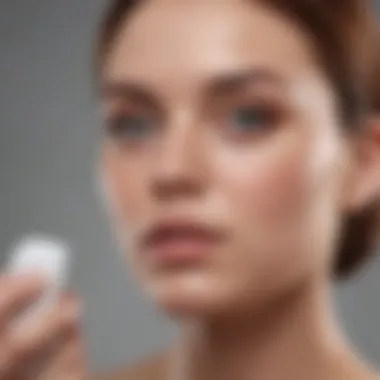Top Acne Spot Treatments You Can Find at Walmart


Intro
Acne remains one of the most common skin concerns affecting individuals of all ages. Finding the right treatment can be daunting due to the multitude of products available, especially at places like Walmart. Understanding which acne spot treatments to choose based on skin type, ingredients, and efficacy is crucial for those seeking clearer skin. In this guide, we will delve into some of the most effective acne spot treatments available at Walmart, emphasizing both widely recognized products and lesser-known gems.
Our exploration will provide insights into key ingredients that effectively target acne, explain product performance based on consumer experiences and dermatologist recommendations, and offer advice on selecting options that suit various skin types. Knowing this information will allow readers to make informed decisions, potentially leading to better results in their battle against acne.
By synthesizing our findings on successful products and common user experiences, we present a coherent approach to managing breakouts that ideally balances pathological treatment with daily skincare regimens. What follows is a detailed examination of the categories and characteristics associated with these treatments, aimed at arming consumers with essential knowledge in pursuit of achieving desired skincare outcomes.
Understanding Acne and Its Types
Understanding acne is essential to approach effective treatments and therapies. The condition affects people across various ages and can greatly impact one's confidence. Knowledge of acne's biology and its types helps in selecting appropriate products for effective management. Additionally, recognizing the differences between type of acne allows one to tailor the treatment accordingly. Ultimately, this understanding builds the foundation for finding suitable acne spot treatments, particularly those available at Walmart.
The Biology of Acne
Acne forms primarily due to the overproduction of oil in the skin, combined with dead skin cells and bacteria. Sebaceous glands produce sebum, an oily substance that can plug hair follicles. This blockage can become inflamed and manifest as different types of acne. Over time, the skin's natural processes may fail, making it important to assist the skin through well-chosen topical treatments and a suitable skincare routine.
Common Types of Acne
Understanding the various types of acne is crucial for efficient treatment. Where different modalities adapt better to each type, one can select and apply the right spot treatments based on their specific needs.
Whiteheads
Whiteheads are formed when clogged pores remain closed. They appear as small white bumps on the skin surface. Their nature makes it tempting to pop them, but this often leads to irritation. In this article, whiteheads serve to illustrate a common non-inflammatory acne type where gentle treatments can be most effective.
Blackheads
Unlike whiteheads, blackheads remain open but get coated by dead skin cells and oil. They appear dark on the top. This oxidation gives them their characteristic color. The removal of blackheads utilizes exfoliation and treatments designed to clear pores, foundational aspects examined further down the article.
Papules
Papules are small red or pink bumps that form when hair follicles become inflamed. They are considered an inflammatory type of acne. This inflammation can cause discomfort. Thus, effective targeting of papules through rightly selected spot treatments can significantly reduce visible inflammation, making them a crucial aspect to consider.
Pustules
Similar to papules, pustules are inflamed but contain pus. Their prominent yellowish-white center represents built-up inflammation. They can often be more noticeable and distressing. A correct approach to managing pustules involves products that address their pus-centered structure aiding faster healing while minimizing scarring.
Nodules
Nodules are larger, solid inflamed lumps embedded deeper under the skin. They represent a severe form of acne and need more focused treatments to reduce inflammation. Given their persistence, understanding one’s skin and available treatments becomes even more critical.
Cysts
Cysts lie at the severe end of the acne spectrum, where large pus-filled bumps form beneath the skin. These often become painful and can lead to significant scarring if not treated appropriately. Cysts require substantial care and specific treatments to mitigate severity while promoting skin recovery. This topic holds relevance for readers who encounter deep-rooted acne that resists simpler treatments.
By demystifying the biology and different types of acne, readers can better navigate their options. This knowledge clarifies how to identify problems areas effectively and opt for acne spot treatments that will yield the most significant results in healing various kinds, imperatively reflecting the correlation between comprehension and suitable treatment choice.
Active Ingredients in Acne Treatments
Understanding the active ingredients in acne treatments provides a clear insight into their effectiveness. Each ingredient addresses particular forms of acne in different ways, and knowing these helps consumers make informed decisions. Many products carry specific claims based on their active components. Evaluating what they do can distinguish effective treatments from less effective options. Let us explore some common ingredients, how they work, and what consumers should consider when buying acne spot treatments.
Benzoyl Peroxide
Benzoyl peroxide is a widely recognized acne treatment and is used singularly or in combination with other ingredients. It works primarily by reducing bacteria on the skin's surface. This is crucial, as bacteria contribute significantly to acne development. In addition, it helps to unclog pores by exfoliating dead skin cells. When applied directly to the blemish, it can create noticeable results.
Some individuals, however, might experience irritation, especially those with sensitive skin. Patch testing is advised to observe any potential adverse reactions. Moreover, its drying effect makes hydration an essential part of post-application care. Optimal results often involve using it consistently while maintaining a balanced skincare routine in conjunction with sunscreen during the day.
Salicylic Acid
Salicylic acid is particularly noted for its ability to penetrate deep into the pores. This ability helps to clear away dead skin cells, thus preventing the clogging of pores. It is favored not just for its exfoliating property but also for its anti-inflammatory benefits. This makes it helpful for both active lesions and predisposed areas. Consumers often choose this ingredient to manage breakouts over prolonged periods.


It is a good choice for all skin types but particularly for those with oily skin. Although milder than benzoyl peroxide regarding drying effects, some users still report slight peeling. Moisture retention remains critical to ensure that skin does not exacerbate dryness.
Sulfur
Sulfur offers a more natural approach to acne treatment, acting as an antimicrobial agent. It helps absorb excess oil from the skin, inhibiting the growth of bacteria that lead to pimples. One of its key advantages is that it is less irritating compared to chemical treatments. However, its smell can be off-putting, which has made sulfur less popular among some consumers.
When suitable concentrations in products are considered, those ingredient lists show promising results for mitigating mild outbreaks. Combining sulfur with other actives like salicylic acid can improve effectiveness for oily and acne-prone skin eventually.
Tea Tree Oil
Tea Tree Oil is another individual treatment recognized for its natural properties in fighting acne. As an essential oil, it contains antimicrobial properties that help in overcoming bacteria responsible for breakouts. People often prefer this organic alternative for its efficacy without unwanted chemicals.
While quite effective, undiluted application should be avoided due to potential irritation. It is often recommended that tea tree oil be mixed with a carrier oil for better tolerance when applied on sensitive skin types. Its uplifting aroma can also create a calming routine – a nonspecialized but enriching aspect to self-care routine.
Understanding these ingredients enables informed choices about treating acne effectively. The benefits and potential drawbacks of active substances point to the necessity of aligning skin type with treatment modalities. Well-informed decisions lead to maximized benefits and minimized side effects.
Criteria for Choosing an Acne Spot Treatment
Selecting the right acne spot treatment is essential for achieving clear skin. Factors that should influence your decision include skin type, acne severity, and sensitivity to specific ingredients. This approach ensures that you find a treatment that does not exacerbate current skin issues and helps in cultivating a routine that works for you.
Skin Type Considerations
Understanding your skin type is crucial in choosing an effective acne spot treatment. Skin individuals have different needs based on their skin properties, such as oiliness or dryness. Treatment products may have formulations specifically designed for:
- Oily Skin: Treatments like those with benzoyl peroxide target excess oil and grime that clog pores.
- Dry Skin: Creams that include hydrators, like hyaluronic acid, can assist in treating acne without further drying.
- Combination Skin: Finding balance is key; a tailored approach using diverse products on different areas may be required.
Awareness of your skin type allows for targeted action and minimizes the chance of skincare-induced complications.
Severity of Acne
The next factor requiring attention is the severity of your acne. Different levels fluctuate from mild breakouts to chronic and severe ones. Here’s how to align the treatment with your acne conditions:
- Mild Acne: Over-the-counter solutions, like those containing salicylic acid, may be effective for balancing skin cells without aggressive treatment.
- Moderate Acne: Products such as Clean & Clear Persa-Gel 10, featuring a higher concentration of benzoyl peroxide, can more actively combat these breakouts.
- Severe Acne: Consulting with a dermatologist is advisable. Persistent acne may be symptomatic of underlying issues that topical treatments cannot resolve alone.
Considering the severity of your acne helps narrow down options that align with the effectiveness desired.
Sensitivity and Reactions
Lastly, take your skin's sensitivity and potential reactions into account. Many acne treatments can cause irritation or redness, which complicates their use:
- Patch Testing: Always conduct a patch test before broad application. A small area application will help gauge any potential adverse reaction.
- Ingredient Awareness: Some ingredients might only act as irritants for some individuals. Familiarize yourself with formulations to find mild yet effective products to reduce the chances of displeasure.
- Professional Guidance: For known skin sensitivities, seeking guidance from professionals can prevent undesired effects. This can help you navigate your choices wisely.
Understanding your skin's reactions is crucial in curating an effective skincare regimen. Pay particular attention to changes following product use.
Popular Acne Spot Treatments at Walmart
Acne remains a common concern for many people. Spot treatments provide a targeted approach to dealing with outbreaks. They directly focus on specific troubled areas, different than regular creams or lotions. This section delves into popular acne spot treatments available at Walmart. The right choice can offer benefits such as quick healing and reduced visibility. Moreover, accessibility plays a key role, as Walmart stores offer a wide selection that can cater to individual needs.
Neutrogena On-the-Spot Acne Treatment
Neutrogena On-the-Spot Acne Treatment is a commonly recognized product. It features benzoyl peroxide, which is known for its effectiveness in treating acne. This treatment works by combating P.acne bacteria, reducing inflammation, and unclogging pores. Users often appreciate its targeted application method, which ensures the treatment goes right onto the blemish.
Typically, users recommend applying it directly to the spot. It dries quickly, minimizing potential mess. Some may notice effects within a short period. However, it is essential to pair this treatment with a suitable skincare routine to get optimal results.
Clean & Clear Persa-Gel
Clean & Clear Persa-Gel 10 is another notable product. This gel also relies on benzoyl peroxide as its active ingredient. The higher concentration, 10%, can provide visible effects in tackling stubborn spots. Many find immediate relief, making it a favorite among frequent acne sufferers. Users appreciate its availability in a gel format, which allows for a more controlled application.
Caution is advised as the higher concentration may lead to dryness. Testing on a small area first can help individuals avoid adverse reactions. Daily use should be accompanied by a good moisturizer to soothe the skin and reduce irritation.


Mario Badescu Drying Lotion
Mario Badescu Drying Lotion offers a unique two-phase formula. This treatment contains both salicylic acid and calamine, effectively helping to dry out spots overnight. Users typically apply it with a cotton swab, making it easy to treat targeted areas. It’s especially favored for its fast-working ability.
The calming elements can assist in reducing redness and inflammation. Many individuals report waking up to significantly clearer skin after overnight use. However, this product is best for more whiteheads or surface breakouts.
Origins Spot Remover
Origins Spot Remover utilizes natural ingredients in its formulation, focusing on tea tree oil as a primary component. This element provides antibacterial properties, making it suitable for sensitive skin. Additionally, its quick-absorbing formula allows users to apply it quickly throughout the day without disruption.
Users often remark on the pleasant scent compared to other options. It may take a bit longer to see noticeable improvement; nonetheless, its gentle formulation makes it preferable for those who might react poorly to stronger treatments.
Understanding these various treatments will help readers navigate their options effectively. Individual skin sensitivities and types create diverse responses, so finding the right product is essential for clear skin. Each of these treatments provides a valuable approach for managing acne in its own way.
Consumer Insights and Reviews
Understanding what real users think about acne spot treatments provides a valuable perspective that goes beyond product descriptions and marketing claims. Consumer insights facilitate prospective buyers to evaluate products more critically. Real-world experiences help in assessing the effectiveness, formulation, and usability of reported treatments. These insights, put together, reveal the challenges people face and how specific solutions worked for them.
Furthermore, reviews often highlight what aspects worked best or triggered adverse effects. The reactions to treatments can vary significantly from individual to individual, emphasizing the need for thorough consideration.
"User reviews illuminate the effectiveness of a product from a customer's viewpoint, making them an essential component of informed skincare choices."
Acne remedies are subjected to different environments like humidity and individual skin types, leading to diverse feedback. Critical elements to consider include:
- Efficacy: User reports help indicate how quickly and effectively a product can reduce acne.
- Texture: Information about how the product feels upon application can influence choices.
- Application Method: Users share experiences that reveal whether the treatment requires special techniques for success.
- Gasponse: Users often provide insights into how well the treatment integrates into daily skincare without clogging pores.
- Long-term results: It is helpful to know not just if individuals had a short-term positive experience but also what happened over weeks or months of usage.
Overall, understanding consumer behavior enriches the buying process, ensuring that readers are not unduly influenced by branding and advertising promises.
Analyzing User Feedback
When navigating the products available at Walmart, reviewing individual testimonials can be particularly illuminating. An analysis compars different feedback sources to draw out key points. Users will share their satisfaction levels regarding effectiveness, irritation, or unexpected reactions. The analysis could directly take into account:
- Ratings: Many users contribute through a star rating system that condenses their satisfaction into easy-to-read levels.
- Before and After Photos: Powerful visual testimonies from users often allow prospective buyers to gauge effectiveness.
- Common Complaints: Recurrent issues raised by different users can pinpoint formulations that may cause trouble, allowing you to make more informed choices.
A company’s response to such feedback also bears merit. Companies addressing consumer concerns demonstrate a commitment to improvement, indicating their seriousness and potentially enhancing consumer trust.
Expert Recommendations
While consumer insights provide anecdotal data, expert recommendations offer a scholarly backdrop. Dermatologists and skincare professionals parse through evident patterns in product formulations. They often possess intricate knowledge about:
- Ingredient Synergy: Recognition of which active ingredients work best together to enhance treatment effectiveness.
- Skin Penetration: Understanding how deeply a product can penetrate the skin layers is critical for identifying which treatments can be effective for various acne types.
- Skin Safety: Professionals emphasize safety first, educating consumers on common allergens and the importance of patch testing.
Lastly, reviews collected from professional skincare forums or significant publications can aid shoppers in separating effective options from gimmicky products. Overall, combining insights from users and merit assessments from experts creates a holistic viewpoint, assisting readers to make choices that suit their unique skin needs.
Application Techniques for Spot Treatments
Applying spot treatment correctly is critical for managing acne effectively. Proper techniques can enhance the effectiveness of the treatment, reduce potential side effects, and lead to clearer skin over time. Understanding how to clean the affected area, apply the treatment, and determine the appropriate timing and frequency can not be overstated.
Cleaning the Area
Before applying any acne spot treatment, it is paramount to prepare the skin properly. This step helps ensure that the products can penetrate effectively. Here are some key points to consider when cleaning the area:
- Use a Mild Cleanser: Choose a gentle formula that will not strip your skin's moisture but still remove dirt and oil.
- Pat Dry Instead of Rubbing: After washing, gently pat the skin dry with a soft towel. Rubbing can create irritation.
- Focus on Targeted Areas: Clean only the zones where acne appears, leaving other areas untouched to maintain overall skin balance.
- Avoid Harsh Scrubs: Do not use abrasive scrubs or harsh cleansers, as they can aggravate your skin.
It is essential to perform this step twice daily, alongside your regular skincare routine, to keep the skin free of impurities and ready for treatment.
Applying the Treatment
Once the area is clean, it is time to apply the spot treatment. The method of application can impact how well the treatment works. Consider these tips:


- Use Clean Hands or Applicator: Always ensure your hands or any tool you use are clean to prevent further contamination of the area.
- Apply a Small Amount: Use a pea-sized amount of treatment directly onto the blemish. This concentrated approach enhances the product's power on that specific spot.
- Gentle Tapping: Rather than rubbing, tap gently at the blemish with your fingertip. This can help the product absorb better.
- Follow As Directed: It's important to follow the manufacturer's directions on how much and where to apply the treatment.
This step is fundamental because accurate application leads to effective results while minimizing side effects.
Timing and Frequency
Knowing when and how often to apply the acne spot treatment is crucial for achieving targeted results. Suggested guidelines include:
- Apply at Night: For many people, nighttime application is most effective, as the skin can heal while at rest.
- Limit to 1-2 Times Per Day: Overuse can cause irritation and dryness, so be mindful of not exceeding the recommended use.
- Monitor Your Skin's Response: Pay attention for any signs of irritation. Adjust frequency based on your skin’s reaction, especially if you notice redness or peeling.
- Don’t Over-Layer with Other Products: Avoid other heavy skincare products on the spot treatment area. It’s best to allow the treatment to set without interference.
Following these strategies will help the potency of these treatments work effectively across individual needs while promoting a healthier skin environment. It's a important step on your journey to healthier-looking skin.
By implementing these application techniques, you can maximize your acne treatment's potency and effectively manage breakouts.
Potential Side Effects of Spot Treatments
Spot treatments for acne can be effective, but it is also important to understand their potential side effects. Not all skin reacts in the same way. Understanding these side effects can help in creating a balanced approach to treating acne.
Skin reactions may set expectations. If someone is using products from Walmart, knowing what side effects to expect can shape choices. Some treatments may irritate the skin, while others can lead to dryness and peeling. Careful assessment of symptoms is key.
Overestimation of a product’s benefits will lead to disappointment, especially if a spot treatment isn't used with appropriate precautions. Targeting acne should not amplify skin problems. Keeping sensitivity and formulation in mind is a critical part of the process.
Irritation and Redness
Irritation and redness are common responses when using many over-the-counter acne spot treatments. These products have active ingredients designed to penetrate the skin and combat breakouts. However, they can be aggressive and may cause noticable irritation, especially for individuals with sensitive skin.
Most commonly, treated areas may feel warm or tender. Redness may develop within hours of application, making it important to do a patch test before applying the treatment to larger areas. If irritation occurs, it is advisable to reducefrequency of use. Alternatively, some people may choose to alternate colder products or hydrating gels instead.
Options for soothing skin include:
- Cold compresses
- Fragrance-free lotion
- Aloe vera gel
Understanding individual skin types helps in mitigating intensity of side effects. Consulting with a dermatologist about recurring irritation is also preferred.
Dryness and Peeling
Dryness and peeling are two significant side effects from acne spot treatments. Active ingredients such as benzoyl peroxide and salicylic acid draw moisture away from the skin, which can leave skin looking dull and feeling tight. Users may also notice flaking skin with continued use, especially if they apply too much product.
Balancing moisturizing techniques is necessary to prevent very visible dryness. Good practices include:
- Using a quality moisturizer post-treatment
- Keeping the skin hydrated o Frequency of use can also influence this effect, listen to how the skin reacts. Adjusting the 'amount' used can minimize overly dry patches can become easy.
In summary, although there are powerful treatments available at Walmart, weighing side effects against their benefits must be done with caution. Educating oneself on reactions ensures better skin care outcomes.
Long-term Maintenance of Clear Skin
Maintaining clear skin is not just about addressing acne when it arises. Long-term skin health relies on regular care and proactive measures. It is crucial because the choices you make today can influence your skin in the future. Acne can not only be physically uncomfortable but can also lead to long-lasting effects on skin texture and tone if left untreated.
A prolonged focus on maintenance each day ensures the skin remains clear and healthy. An effective skincare routine helps prevent the emergence of new blemishes and reduces the potential for scarring. Furthermore, it builds a resilient skin barrier that can better withstand environmental stressors.
Integrating a Comprehensive Skincare Routine
Creating a skincare routine involves angel arrangements for cleansing, treating, and hydrating the skin.
- Cleansing: Start with a gentle cleanser suited for your skin type to remove dirt and oil without stripping moisture.
- Targeted Treatment: Following cleansing, apply a targeted acne spot treatment. This is essential as it allows specific areas of concern to be treated effectively.
- Moisturizing: Using a non-comedogenic moisturizer daily will help maintain skin hydration without clogging pores.
- Sunscreen: Daily application of broad-spectrum sunscreen is non-negotiable. It prevents darkening of marks left by acne and protects the skin from UV damage.
It's important to adjust the products in your routine based on seasons and skin changes to ensure that they meet the evolving needs of your skin.
When to Seek Professional Help
Sometimes, over-the-counter treatments may not suffice. It is necessary to consult a dermatologist if you experience any of the following:
- Persistent acne that ultimately does incrase or scars.
- Severe breakouts could lead to further skin inconvinence or embarrassment.
- Unfamiliar or painful lesions, as these might signify an underlying condition that needs evaluation.
A dermatologist can tailor treatment plans based on individual needs, which may include prescription medication or advanced procedures. Establishing a strong professional relationship can provide ongoing education and support for maintaining clear skin long-term.
Remember, investing in milestones of professional advice may be a pivotal moment for enhancing your skin's health!







